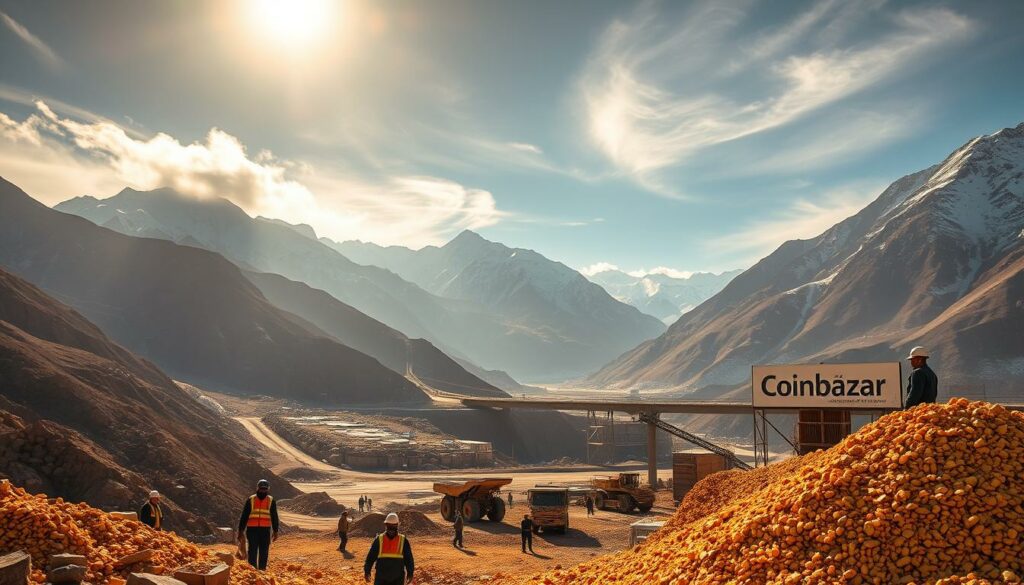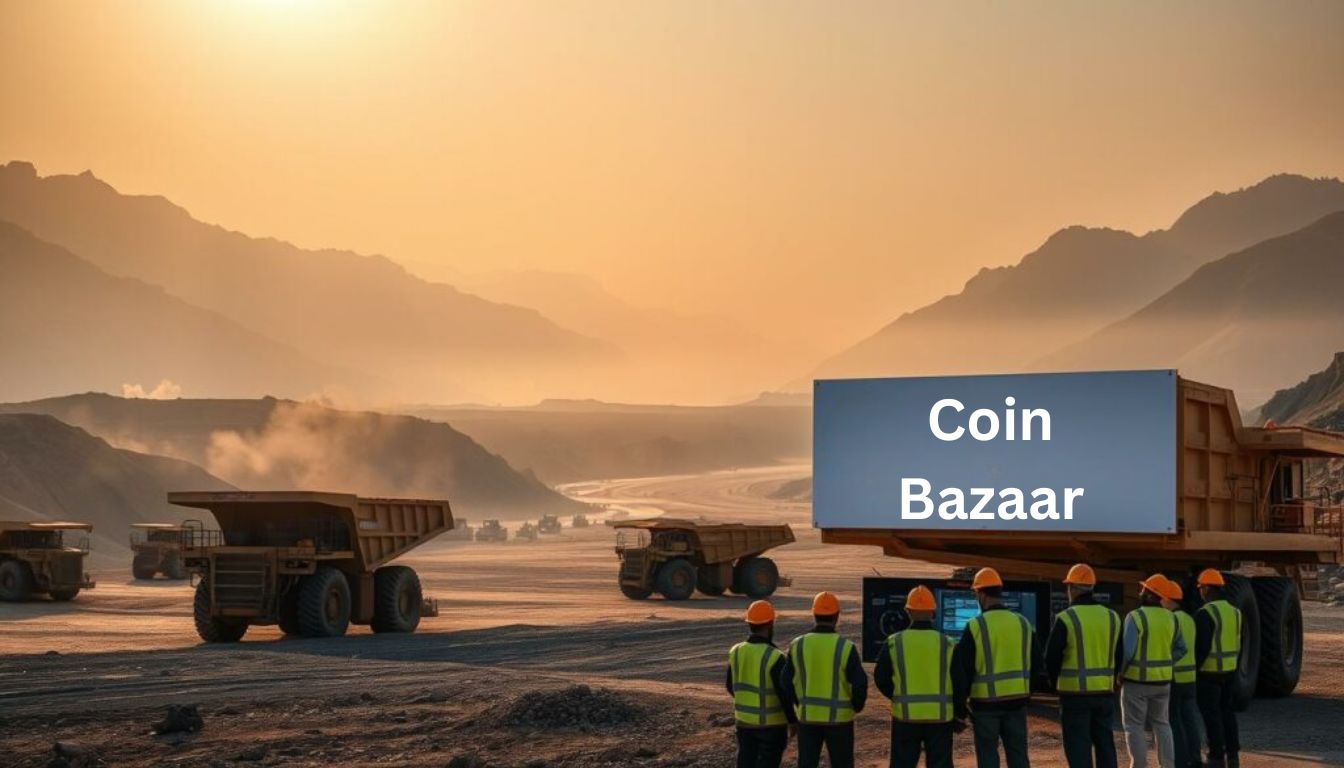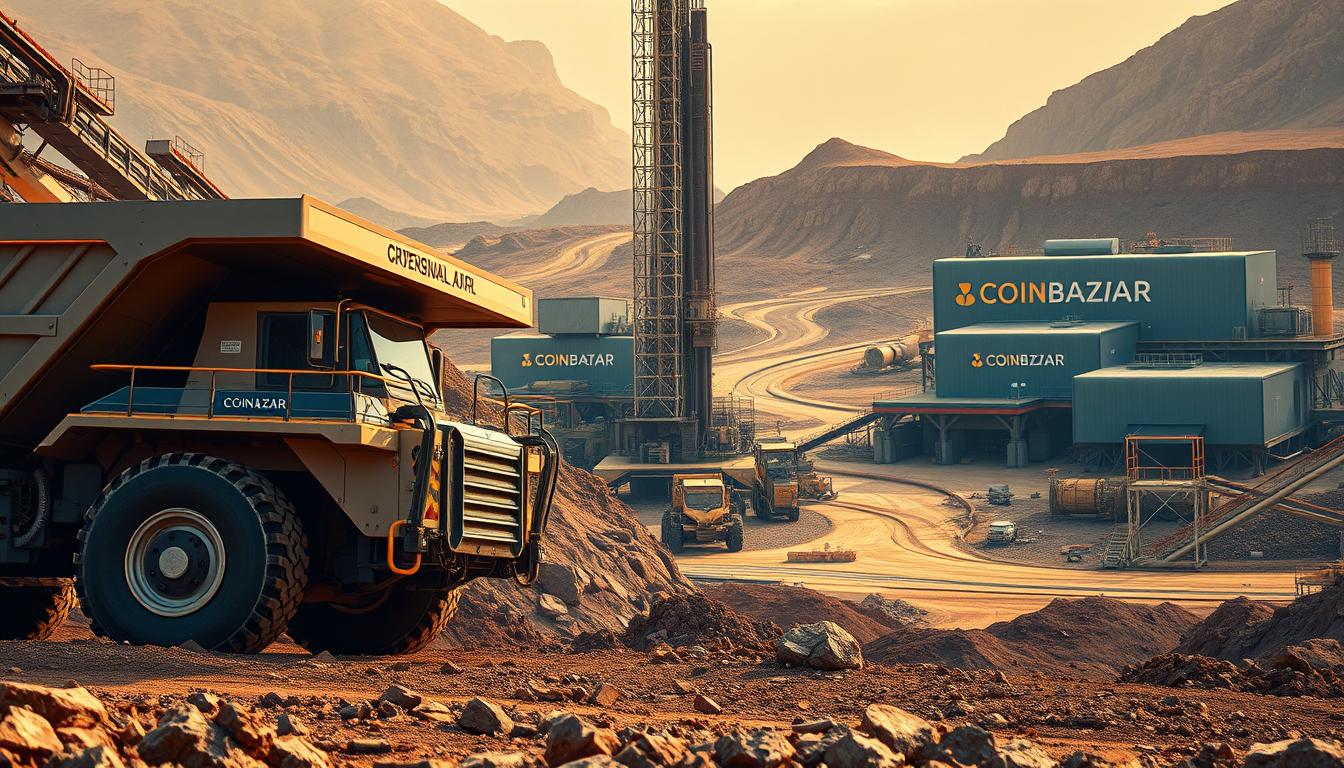The Precious Metals Mining industry is changing fast, thanks to Technological Innovations. More people want precious metals for things like jewelry, electronics, and renewable energy.
The market for precious metals is set to grow. It will go from US$313.5 Bn in 2024 to US$456 Bn by 2031. This growth is because of better Mining Technology. It makes getting metals easier and cheaper.
Key Takeaways
- The precious metals market is expected to grow at a CAGR of 5.5% from 2024 to 2031.
- Technological innovations are driving growth in the precious metals mining industry.
- Advances in mining technology have improved extraction efficiency and reduced costs.
- The demand for precious metals is rising, driven by various industries.
- The market is projected to reach US$456 Bn by 2031.
The Current State of Precious Metals Mining in India
The world of precious metals mining in India is shaped by many factors. It’s key to grasp the current situation in this field.
Key Mining Regions and Resources in the Indian Subcontinent
India’s mining scene is mainly found in a few key areas. The country has lots of gold and other precious metals, especially in Karnataka, Andhra Pradesh, and Jharkhand. These places have been vital to India’s mining for years.


Traditional Mining Methods Still in Use Today
Even with new tech, old mining ways are still common in India. Artisanal and small-scale mining are big, especially where new tools haven’t arrived yet. These methods, though hard, have been around for ages.
The industry also feels the impact of global issues like inflation and currency changes. This makes it a complex and ever-changing field.
Evolution of Mining Technology in the Indian Context
The mining technology in India is changing fast. This change is making mining of precious metals better. You’ll see how old ways led to new tech.
Historical Mining Techniques in India
India’s mining history goes back centuries. Old methods were used to get precious metals. These simple ways helped create today’s advanced tech.
- Manual extraction techniques were mainly used.
- Simple tools made from local materials were used.
- Community-based mining was common.
Now, new tech is replacing old methods. This change is for better efficiency and safety.
Your Guide to India’s Digital Transformation in Mining
India’s mining is getting a digital makeover. New tech is being used. You’ll see:
- Automation: Making work more efficient and reducing manual labor.
- Artificial Intelligence (AI): Better predictive maintenance and resource estimation.
- Data Analytics: Helping make better decisions with real-time data.
This tech change is making mining safer and less harmful to the environment. It’s also making mining more productive.
Looking ahead, India’s mining tech will keep evolving. Digital innovations will lead the way to a greener and more efficient mining future.


Advanced Exploration Technologies Transforming the Industry
The mining industry is on the verge of a big change. New technologies are making exploration better and cheaper. They also help find minerals more accurately, which is good for the environment and saves money.
Satellite and Drone-Based Mineral Mapping
Satellite and drone technology is changing the game in mining. They can gather detailed data over large areas. This helps geologists find mineral deposits more easily.
How These Technologies Work for You
Drones and satellites use advanced sensors to scan the ground. They can spot minerals and map underground structures. This info is key for planning mining activities.
Cost-Benefit Analysis for Indian Operators
For Indian miners, using these technologies can cut costs. Experts say drones can lower costs by up to 20%.
“The use of drones in mining can reduce exploration costs by up to 20%.”
AI-Powered Geological Modeling
AI is making big strides in mining. It helps create detailed 3D models of underground geology. This helps find mineral deposits.
Benefits of AI-Powered Modeling:
- More accurate mineral deposit finding
- Deeper understanding of underground geology
- Better planning for mining
Seismic Imaging Breakthroughs
Seismic imaging has made huge leaps. It now offers clearer views of underground structures. This tech is key for spotting mineral deposits and understanding the geology.
As mining uses these new technologies, we’ll see big improvements. Indian miners can stay ahead in the global market. They can also reduce their environmental impact.
Automation and Robotics Revolutionizing Mining Operations
The mining industry is on the verge of a big change. Automation and robotics are leading this transformation. These technologies are making mining safer, more efficient, and productive. They are becoming essential for modern mining.
Autonomous Drilling and Blasting Systems
Autonomous drilling and blasting systems are key to this change. They use GPS and sensors to drill and blast rock accurately. This reduces waste and boosts ore recovery. It also makes mining safer by reducing human risk.
The benefits are clear:
- Increased precision and accuracy
- Improved safety through reduced human intervention
- Enhanced productivity and efficiency
Robotic Mining Equipment Changing the Game
Robotic mining equipment is another big step forward. These machines can work in tough environments, doing tasks that were hard or dangerous for humans. They help increase productivity and lower costs.
Some key advantages include:
- Continuous operation without breaks
- Ability to work in hazardous conditions
- Precision in task execution
Remote Operation Centers: The Future is Now
Remote operation centers are changing how mining is managed. They let you control equipment and watch operations from afar. This improves safety, cuts the need for on-site workers, and boosts oversight.
The benefits of remote operation centers include:
- Enhanced safety through reduced on-site personnel
- Improved operational control and monitoring
- Increased efficiency and productivity
How Data Analytics and AI Are Reshaping Precious Metals Mining
Data analytics and AI are changing mining for precious metals. They help with predictive maintenance, making operations more efficient, and better estimating resources. Mining companies can now make smarter choices, run their operations better, and boost productivity.
Predictive Maintenance Systems You Can Implement
Predictive maintenance is key in mining. It lets you spot equipment problems early. With data analytics and AI, you can cut downtime, save on maintenance, and make your equipment last longer.
Sensors track equipment health in real-time. Machine learning then uses this data to forecast when maintenance is needed.
Operational Efficiency Optimization Techniques
Data analytics and AI help make mining operations more efficient. AI can spot bottlenecks and suggest fixes. Data analytics also helps cut energy use, reduce waste, and improve logistics.
By using these methods, you can make your mine more efficient and save money.
Resource Estimation Improvements Through Technology
Getting accurate resource estimates is vital in mining. Data analytics and AI can do this by analyzing geological data and spotting patterns. This leads to more precise reserve estimates and better decisions.
| Technology | Application | Benefit |
|---|---|---|
| Geological Modeling | Analyzing geological data to create detailed models | More accurate reserve estimates |
| Machine Learning | Identifying patterns in data to predict mineralization | Improved exploration targeting |
| Spatial Analysis | Analyzing spatial data to understand mineral distribution | Better mine planning and optimization |
By using data analytics and AI, you can greatly improve your mining operations. This leads to better productivity, lower costs, and higher profits.
Modern Extraction and Processing Innovations You Should Know
Modern extraction and processing innovations are changing the precious metals mining sector. They make operations more efficient and sustainable. These advancements are transforming the industry.
The way we extract and process precious metals has changed a lot. New technologies are improving yields and reducing environmental impact.
Advanced Crushing and Grinding Technologies
Innovations in crushing and grinding have made a big difference. High-pressure grinding rolls (HPGR) and stirred mills are more efficient. They use less energy and help get more precious metals from ore.
Key benefits of advanced crushing and grinding technologies include:
- Reduced energy consumption
- Increased throughput
- Improved liberation of precious metals
Eco-Friendly Chemical Processing Methods
The industry is moving towards eco-friendly chemical processing. Old methods used harmful chemicals. Now, safer alternatives are available.
Cyanide-Free Gold Recovery
Cyanide-free gold recovery is becoming popular. It’s safer and better for the environment. Methods like thiosulfate leaching and glycine leaching are being used.
Mercury-Free Processing Options
Mercury-free processing is another important innovation. Mercury poses big risks in mining. New methods, like using borax, aim to replace mercury.
Recovery Rate Enhancements for Better Yields
Improving recovery rates is key for better extraction. New technologies, like advanced flotation cells and gravity separation, help achieve this.
| Innovation | Benefits | Impact |
|---|---|---|
| Advanced Crushing and Grinding | Reduced energy consumption, increased throughput | Improved efficiency and reduced costs |
| Eco-Friendly Chemical Processing | Safer alternatives to hazardous chemicals | Reduced environmental and health risks |
| Recovery Rate Enhancements | Better yields through advanced technologies | Increased profitability for mining operations |
The precious metals mining industry is evolving fast. Adopting these modern innovations is crucial for staying competitive and sustainable.
Safety Innovations Protecting Indian Miners
Safety innovations are changing the mining sector in India. They reduce risks and improve miner well-being. The industry is using new technologies to protect its workers.
Wearable Safety Technology in Harsh Environments
Wearable safety technology is getting more popular in Indian mines. These devices track miners’ vital signs and location. They also detect hazardous conditions, allowing for quick action in emergencies.
For example, smart helmets with sensors can spot falls, gas leaks, or other dangers. They alert supervisors and rescue teams right away.
Wearables do more than just monitor health. They also help mines work better. By tracking equipment and conditions, mines can avoid accidents and improve efficiency.
Real-Time Monitoring Systems Saving Lives
Real-time monitoring systems are key in Indian mining. They use sensors and IoT devices to watch mine conditions all the time. This helps find and fix hazards like gas buildup or structural issues.
For instance, advanced gas detection systems can find toxic gases. They trigger alarms and ventilation to stop accidents. Ground movement systems also predict and prevent rockfalls in underground mines.
Virtual Reality Training Programs for Your Workforce
Virtual Reality (VR) training is changing miner training in India. VR programs mimic real-world dangers. They help miners learn how to react in emergencies.
VR training is done in a safe space. It lowers the chance of accidents during training. It also makes sure all miners get the same quality training, no matter where they work.
| Safety Innovation | Description | Benefits |
|---|---|---|
| Wearable Safety Technology | Tracks miners’ vital signs and location | Enhanced health monitoring, swift emergency response |
| Real-Time Monitoring Systems | Monitors mine conditions continuously | Immediate hazard detection, risk mitigation |
| Virtual Reality Training | Simulates real-world scenarios for training | Improved response skills, standardized training |
Indian mines are using these safety innovations to protect their workers. They are also making mining safer and more efficient. As mining evolves, using advanced safety technologies will keep being important.
Environmental Sustainability Technologies in Mining
Environmental sustainability technologies are changing mining. They make your operations greener and cut down on harm to the environment. As mining grows, using these technologies is key to lessening environmental harm while keeping operations smooth.
Water Conservation and Recycling Systems for Arid Regions
In dry areas, finding enough water is hard for mines. Water-saving and recycling systems help a lot. For example, new water treatment tech lets mines use water again, saving local water sources.
Here are ways to save water:
- Use dry processing when you can
- Choose advanced dewatering tech
- Recycle water from tailings ponds
Energy-Efficient Mining Equipment for Your Operations
Switching to energy-saving mining gear is vital for lessening harm to the environment. New machines use less energy but work just as well or better. Electric trucks and drills, for instance, cut down on pollution and save money over time.
Energy-saving gear offers many benefits:
| Benefit | Description | Impact |
|---|---|---|
| Reduced Energy Consumption | Less fuel or electricity needed | Lower costs |
| Lower Emissions | Less pollution | Good for the planet |
| Increased Productivity | Better machine performance | More efficient |
Mine Rehabilitation Innovations Meeting Indian Regulations
Mine cleanup is key to environmental care, especially in India where rules are strict. New cleanup methods not only fix ecosystems but also follow rules. Bio-reclamation and using local plants for replanting are becoming more common.
Using these new methods means your mines will follow Indian laws and help nature in mined places.
Important cleanup strategies include:
- Managing and putting back topsoil
- Planting native plants
- Keeping an eye on and caring for the cleaned-up areas
Blockchain and Traceability in Your Precious Metals Supply Chain
The precious metals market is complex, but blockchain is making it simpler. It’s changing how we source, trade, and verify precious metals. This leads to a more open and safe supply chain.
Ensuring Ethical Sourcing in the Indian Market
Blockchain creates an unchangeable record of a metal’s origin and journey. This enhanced traceability means your metals are ethically sourced. It follows rules and lowers the chance of supporting bad practices.
Reducing Fraud and Theft Through Technology
Blockchain cuts down fraud and theft risks in the supply chain. Every transaction is logged on a shared ledger, making it hard to alter records. This transparency and safety increase trust among all parties.
| Benefits | Description |
|---|---|
| Enhanced Traceability | Immutable record of origin and ownership |
| Reduced Fraud | Decentralized ledger prevents record manipulation |
| Market Transparency | Clear and publicly accessible transaction history |
Improving Market Transparency for Global Competitiveness
Blockchain offers a clear, public record of transactions. This boosts market transparency. It’s key for your business to stay ahead globally, as it fosters trust and credibility.
Economic Impact of Technology Advancements on Indian Precious Metals Mining
Technology has a big impact on Indian precious metals mining. It makes operations more efficient and opens up new economic opportunities. This shows how technology is changing the game in mining.
Job Creation and Skill Development Opportunities
Advanced technologies in mining have created new jobs. These jobs need special skills, like operating new equipment. This means more focus on training workers, helping the workforce grow.
Production Efficiency and Profitability Improvements
Technology has made mining in India more efficient. It uses better exploration methods, automated mining, and data analysis. These help lower costs and increase profits. By using these technologies, mining operations can get better results.
Foreign Investment Attraction Through Modernization
India’s mining industry is becoming more modern with technology. This makes it more appealing to foreign investors. They want to invest in efficient and sustainable mining operations. This brings in more money to grow the sector.
In summary, technology has a big impact on Indian precious metals mining. It leads to economic growth, better operations, and more foreign investment. This helps the mining sector grow and develop sustainably.
Case Studies: Successful Implementation in Indian Mines
Advanced technologies have boosted productivity and sustainability in Indian mines. This section shares three key examples of how modern mining tech has been successfully used.
Kolar Gold Fields Modernization Journey
The Kolar Gold Fields, a major gold mining site in India, saw big changes. Advanced exploration techniques helped them better understand their resources. This led to more accurate estimates of what they had.
Zawar Mines Digital Transformation Success Story
Zawar Mines, run by Hindustan Zinc Limited, started a digital transformation. They used real-time monitoring systems and data analytics to make their operations better.
Rampura Agucha’s Automation Achievements
Rampura Agucha, also by Hindustan Zinc Limited, made big strides in automation. They introduced autonomous drilling and blasting systems.
| Mine | Technology Implemented | Outcome |
|---|---|---|
| Kolar Gold Fields | Advanced Exploration Techniques | Improved Resource Estimation |
| Zawar Mines | Real-time Monitoring, Data Analytics | Operational Optimization |
| Rampura Agucha | Autonomous Drilling and Blasting | Increased Efficiency and Safety |
These examples show how tech can change the Indian mining industry for the better.
Future Trends in Precious Metals Mining Technology
The future of precious metals mining is changing fast. New technologies are coming that will change the game. It’s important to know what’s coming next in this field.
Quantum Computing Applications on the Horizon
Quantum computing is set to change precious metals mining. It can process huge amounts of data quickly. This could make things like finding resources and planning mines much better.
Quantum computers can look at lots of geological data to find patterns. This could help find mineral deposits more accurately. It could also make exploring for resources more efficient.
Bioleaching and Biomining Advancements for Sustainable Mining
Bioleaching and biomining are getting better too. These use microorganisms to get metals from ores. They are a greener way to mine than old chemical methods.
These methods are great for low-grade ores or complex minerals. As research grows, they will get even better. This makes them a good choice for mining.
Deep-Sea Mining Technologies: India’s Oceanic Frontier
Deep-sea mining is a new area for mining precious metals. India, with its long coast, is ready to explore it. It involves mining the ocean floor for metals like copper and gold.
Deep-sea mining tech is growing fast. It could offer new ways to mine and might be better for the environment than land mining.
| Technology | Potential Impact | Benefits |
|---|---|---|
| Quantum Computing | Revolutionize resource estimation and mine planning | Faster data processing, more accurate predictions |
| Bioleaching/Biomining | Environmentally friendly extraction method | Efficient for low-grade ores, reduced environmental impact |
| Deep-Sea Mining | Access to new reserves of precious metals | Potential for less environmental impact, new resource opportunities |
These technologies will be key in the future of mining. Keeping up with these trends can help you lead in innovation.
Conclusion: Embracing Innovation for a Sustainable Mining Future
The precious metals mining industry is changing fast. To keep up, we must embrace new ideas. This means using the latest technologies to work better, protect the environment, and keep everyone safe.
In India, mining has made big strides in finding, extracting, and processing minerals. To keep leading, we need to keep investing in new ideas. We should also work together with tech experts.
This way, we can grow, use resources wisely, and help the planet. The future of mining in India relies on our ability to innovate. By embracing new ideas, we can ensure a sustainable mining future.















8 Responses
Interesting point about traditional mining still being used in India. It makes me think about the role of training and education in helping workers transition to newer technologies—definitely something that could shape the future of the industry.
It’s fascinating to see how mining tech is advancing—especially when it comes to improving efficiency and lowering costs. I wonder how quickly traditional methods in India will be replaced or integrated with newer technologies?
The projected growth of the precious metals market really highlights how crucial technology has become in mining. It’d be interesting to explore how these innovations are balancing efficiency with environmental responsibility, especially as demand grows in sectors like electronics and renewable energy.
As the demand for metals rises in industries like electronics and renewable energy, it’s smart that the mining sector is keeping pace with tech innovation. Curious to see how regulations will adapt alongside.
It’s fascinating to see how innovations in mining tech are reducing costs while meeting rising demand. I wonder how these advancements might help modernize India’s traditional mining practices, especially in regions like Jharkhand.
It’s fascinating to see how technology is reshaping such a traditionally labor-intensive industry. Curious to know how India’s adoption of these innovations compares with global trends—especially since many regions are still using traditional methods.
This is a fascinating look at how technological innovations are transforming the precious metals industry. I find it especially interesting how advancements in mining technology are not only improving extraction efficiency but also driving cost reductions—making metals more accessible for industries like electronics and renewable energy. It will be exciting to see how India’s mining regions adapt to these innovations while balancing the use of traditional methods.
It’s interesting to see how technological innovations are not just improving efficiency but also reshaping the global market trajectory for precious metals. I wonder how quickly these advancements can be adopted in regions like India that still rely heavily on traditional mining practices.